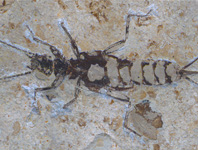Abstract
Pseudotrichonotus belos new species, described from three specimens trawled in 100–120 m offshore between Exmouth Gulf and Shark Bay, Western Australia, represents the first record of the sand-diving fish family Pseudotrichonotidae from Australian waters. It differs from its two congeners in having a more posteriorly positioned dorsal fin (predorsal length 39.6–41.2 % SL) and fewer dorsal- and anal-fin rays (31–33 and 12, respectively).
References
Johnson, G.D., Baldwin, C.C., Okiyama, M. & Tominaga, Y. (1996) Osteology and relationships of Pseudotrichonotus altivelis (Teleostei: Aulopiformes: Pseudotrichonotidae). Ichthyological Research, 43, 17–45.
https://doi.org/10.1007/BF02589606Johnson, R.K. (1982) Fishes of the families Evermanellidae and Scoleparchidae: systematics, morphology, interrelationships, and zoogeography. Fieldiana Zoology (new series), 12, 1–252.
Machida, Y. (1988) Pseudotrichonotidae. In: Masuda, K., Amaoka, K., Araga, C., Uyeno, T. & Yoshino, T. (Eds.), The Fishes of the Japanese Archipelago. Second Edition. Tokai University Press, Tokyo, pp. 60–60.
Masuda, H., Araga, C. & Yoshino, T. (1975) Coastal Fishes of Southern Japan. Tokai University Press, Tokyo, 379 pp.
Nakabo, T. (2002) Pseudotrichonotidae. In: Nakabo, T. (Ed.) Fishes of Japan With Pictorial Keys to the Species. English Edition, volume 1. Tokai University Press, Tokyo, pp. 350–350.
Parin, N.V. (1992) Pseudotrichonotus xanthotaenia (Pseudotrichonotidae, Aulopiformes) -- a new fish from the Saya-de-Malha submarine rise. Voprosy Ikhtiologii, 32, 156–158. [In Russian. English translation in Journal of Ichthyology, 32, 128–131.
Saruwatari, T., López, J.A. & Pietsch, T.W. (1997) Cyanine blue: a versatile and harmless stain for specimen observation. Copeia, 1997, 840–841.
https://doi.org/10.2307/1447302

